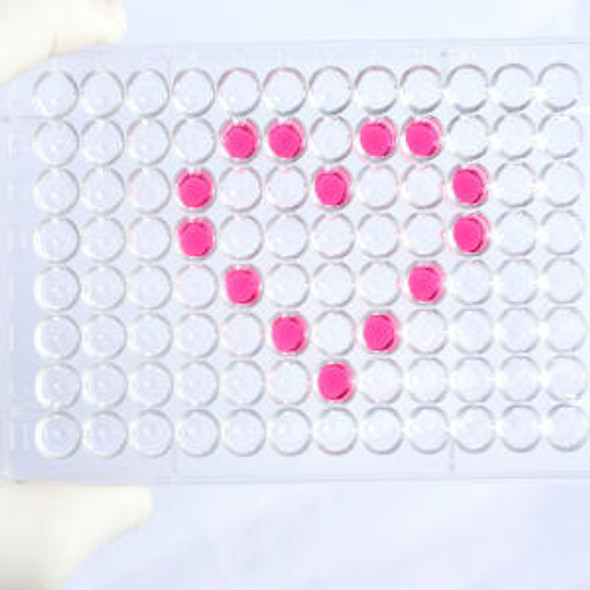Human BMPR1A Recombinant Protein (RPPB0090)
- SKU:
- RPPB0090
- Product type:
- Recombinant Protein
- Size:
- 100ug
- Species:
- Human
- Target:
- BMPR1A
- Synonyms:
- BMPR-1A
- BMP-R1A
- BMPR1A
- BMR1A
- Source:
- Chinese Hamster Ovary Cells (CHO)
- Uniprot:
- P36894
Description
| Product Name: | Human BMPR1A Recombinant Protein |
| Product Code: | RPPB0090 |
| Size: | 100µg |
| Species: | Human |
| Target: | BMPR1A |
| Synonyms: | BMPR-1A, BMP-R1A, BMPR1A, BMR1A, CD292, CD-292, Serine/threonine-protein kinase receptor R5, SKR5, ALK-3, ACVRLK3, EC 2.7.11.30, CD292 antigen. |
| Source: | Chinese Hamster Ovary Cells (CHO) |
| Physical Appearance: | Sterile Filtered White lyophilized (freeze-dried) powder. |
| Formulation: | The protein was lyophilized from a sterile (0.2µm) filtered solution containing PBS. |
| Solubility: | It is recommended to reconstitute the lyophilized BMPR1A in sterile 18M?-cm H2O not less than 100µg/ml, which can then be further diluted to other aqueous solutions. |
| Stability: | Lyophilized BMPR1A although stable at room temperature for 3 weeks, should be stored desiccated below -18°C. Upon reconstitution BMPR1A should be stored at 4°C between 2-7 days and for future use below -18°C.Please prevent freeze-thaw cycles. |
| Purity: | Greater than 95.0% as determined by SDS-PAGE. |
| Amino Acid Sequence: | QNLDSMLHGT GMKSDSDQKK SENGVTLAPE DTLPFLKCYC SGHCPDDAIN NTCITNGHCF AIIEEDDQGE TTLASGCMKY EGSDFQCKDS PKAQLRRTIE CCRTNLCNQY LQPTLPPVVI GPFFDGSIRI EGRMDDKTHT CPPCPAPELL GGPSVFLFPP KPKDTLMISR TPEVTCVVVD VSHEDPEVKF NWYVDGVEVH NAKTKPREEQ YNSTYRVVSV LTVLHQDWLN GKEYKCKVSN KALPAPIEKT ISKAKGQPRE PQVYTLPPSR DELTKNQVSL TCLVKGFYPS DIAVEWESNG QPENNYKTTP PVLDSDGSFF LYSKLTVDKS RWQQGNVFSC SVMHEALHNH YTQKSLSLSP GK |
| Biological Activity: | The ED50, as calculated by the Inhibition of human BMP-4-induced alkaline phosphatase production caused by ATDC5 cells is 120ng/ml corresponding to a specific activity of 8.3x10^3 units/mg. |
The bone morphogenetic protein (BMP) receptors are a family of transmembrane serine/threonine kinases that include the type I receptors BMPR1A and BMPR1B and the type II receptor BMPR2. These receptors are also closely related to the receptors, ACVR1 and ACVR2. The ligands of these receptors are members of the TGF-beta superfamily. TGF-betas transduce their signals through the formation of heteromeric complexes with 2 different types of serine (threonine) kinase receptors: type I receptors of about 50-55 kD and type II receptors of about 70-80 kD. Type II receptors bind ligands in the absence of type I receptors, but they require their respective type I receptors for signaling, whereas type I receptors require their respective type II receptors for ligand binding.
Bone Morphogenetic Protein Receptor-1A Human Recombinant produced in CHO cells is a glycosylated homodimer chain containing 2x362 amino acids and having a total molecular mass of 80.8kDa.BMPR1A is purified by proprietary chromatographic techniques.
| UniProt Protein Function: | BMPR1A: a serine/threonine-protein kinase receptor for Bone morphogenetic protein-2 and -4 (BMP-2 and BMP-4). Defects in BMPR1A are a cause of juvenile polyposis syndrome (JPS) and Cowden disease (CD), a cancer syndrome characterized by multiple hamartomas and by a high risk for breast, thyroid and endometriel cancers. |
| UniProt Protein Details: | Protein type:Protein kinase, Ser/Thr (receptor); Kinase, protein; Membrane protein, integral; Protein kinase, TKL; EC 2.7.11.30; TKL group; STKR family; Type1 subfamily Chromosomal Location of Human Ortholog: 10q22.3 Cellular Component: cell soma; dendrite; integral to membrane; plasma membrane; caveola Molecular Function:transforming growth factor beta receptor activity; protein serine/threonine kinase activity; protein binding; protein homodimerization activity; metal ion binding; SMAD binding; ATP binding; transmembrane receptor protein serine/threonine kinase activity; receptor signaling protein serine/threonine kinase activity Biological Process: neural plate mediolateral pattern formation; transcription from RNA polymerase II promoter; developmental growth; hindlimb morphogenesis; neural crest cell development; positive regulation of transcription, DNA-dependent; paraxial mesoderm structural organization; mesendoderm development; dorsal/ventral axis specification; palate development; protein amino acid phosphorylation; negative regulation of neurogenesis; BMP signaling pathway; transforming growth factor beta receptor signaling pathway; positive regulation of mesenchymal cell proliferation; ectoderm development; Mullerian duct regression; somitogenesis; in utero embryonic development; lateral mesoderm development; stem cell maintenance; positive regulation of bone mineralization; odontogenesis of dentine-containing teeth; positive regulation of osteoblast differentiation; mesoderm formation; pituitary gland development; cartilage development; embryonic organ development; immune response; embryonic digit morphogenesis; regulation of lateral mesodermal cell fate specification; positive regulation of epithelial cell proliferation; lung development Disease: Juvenile Polyposis Syndrome; Polyposis Syndrome, Hereditary Mixed, 2 |
| NCBI Summary: | The bone morphogenetic protein (BMP) receptors are a family of transmembrane serine/threonine kinases that include the type I receptors BMPR1A and BMPR1B and the type II receptor BMPR2. These receptors are also closely related to the activin receptors, ACVR1 and ACVR2. The ligands of these receptors are members of the TGF-beta superfamily. TGF-betas and activins transduce their signals through the formation of heteromeric complexes with 2 different types of serine (threonine) kinase receptors: type I receptors of about 50-55 kD and type II receptors of about 70-80 kD. Type II receptors bind ligands in the absence of type I receptors, but they require their respective type I receptors for signaling, whereas type I receptors require their respective type II receptors for ligand binding. [provided by RefSeq, Jul 2008] |
| UniProt Code: | P36894 |
| NCBI GenInfo Identifier: | 61252444 |
| NCBI Gene ID: | 657 |
| NCBI Accession: | P36894.2 |
| UniProt Secondary Accession: | P36894,Q8NEN8, A8K6U9, |
| UniProt Related Accession: | P36894 |
| Molecular Weight: | Calculated: 60kDaObserved: 69kDa |
| NCBI Full Name: | Bone morphogenetic protein receptor type-1A |
| NCBI Synonym Full Names: | bone morphogenetic protein receptor, type IA |
| NCBI Official Symbol: | BMPR1A |
| NCBI Official Synonym Symbols: | ALK3; SKR5; CD292; ACVRLK3; 10q23del |
| NCBI Protein Information: | bone morphogenetic protein receptor type-1A; ALK-3; BMPR-1A; BMP type-1A receptor; activin receptor-like kinase 3; activin A receptor, type II-like kinase 3; serine/threonine-protein kinase receptor R5 |
| UniProt Protein Name: | Bone morphogenetic protein receptor type-1A |
| UniProt Synonym Protein Names: | Activin receptor-like kinase 3; ALK-3; Serine/threonine-protein kinase receptor R5; SKR5; CD_antigen: CD292 |
| Protein Family: | Bone morphogenetic protein receptor |
| UniProt Gene Name: | BMPR1A |
| UniProt Entry Name: | BMR1A_HUMAN |










